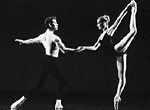Pacific Northwest Ballet (November): There’s a moment in the pas de deux of George Balanchine’s Agon where the couple comes to an abrupt halt after a limb-rending race across the stage. Arms linked, they reach across with their free hands and grasp their wrists, an action totally without virtuosity and yet one of the most indelible parts of the work. We pay attention to it because the dancers do, and in their recent performance Patricia Barker and Olivier Weevers made us feel each separate finger as it contacted skin. We wouldn’t have been surprised if they left burn marks.
Dance This (Moore Theater, July): The Moore Theater was in danger of losing its roof at the end of this dynamite program sponsored by the Seattle Landmark Association. The showcase of youth companies from around the area included traditional dances as well as more contemporary material, but whether they were moving to classic drum rhythms or a cut from the latest Ricky Martin CD, their love of dancing shone. The swing number to Brian Setzer’s “Jump, Jive and Wail” was a crowd-pleaser, but it was Wayne Bascomb’s finale, where everyone danced everything from classical Cambodian dance to hip-hop, that could make you weep.
White Oak Dance Project (Meany Theater, May): Although it’s been years since Mikhail Baryshnikov, director and first dancer of the White Oak Dance Project, performed in the standard ballet repertory, his reputation as a dance superstar endures and continues to draw audiences into the theater. The dancing they see, though, is some of the most challenging contemporary choreography—far removed from Giselle and Swan Lake. With a Kabuki-influenced solo by Tamasaburo Endo that was rigorous in its simplicity, and postmodernist Trisha Brown’s Glacial Decoy coiling through its exercises in retrograde and reversal, the audience came to see a legend and got a recent history lesson as well.
Arthur Duncan (with Cheryl Johnson and Anthony Peters, Shoreline Arts Center, March): Arthur Duncan was one of the few tap dancers visible during tap’s low period in the 1960s, thanks to his place on the Lawrence Welk Show. Despite the uncomfortable social and racial stereotypes surrounding those performances, he was a link to a dance style that fuses African polyrhythms with other European dance practices. Now, at a time of renewed interest in tap, he’s still around to share the stage with a younger generation, and in an art form where 40 is often considered retirement age, his presence is a special blessing.
Dance in advertising: What do Mervyns, Tylenol, the Gap, Vern Fonk Insurance, Pentium computer chips, and Varathane have in common? They’ve all used dance in some form or another in their television advertising over the last year. A couple swirls through a house decorated for Christmas with consumables by Mervyns, hip-hoppers in clean suits breakdance with PCs, and those Gap khakis know just about every social dance in the 20th century. For someone who’s happy to see dancing in any setting, these commercials are, as Martha Stewart might say, “a good thing.”








